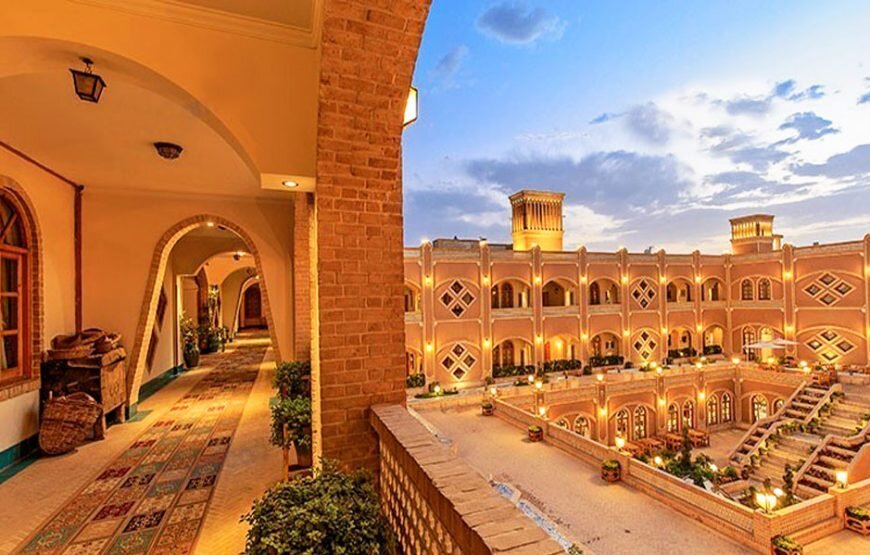Yazd hotels to trial scheme for handicrafts’ practical application

TEHRAN – The UNESCO-designated city of Yazd has been selected for a pilot project to ensure a practical application of handicrafts in its hotels and guest houses.
Yazd has been chosen as a pilot city for implementing the practical application of handicrafts in Iran’s accommodation and hospitality units, Mehr reported on Tuesday.
The decision was made at a recent session attended by Maryam Jalali-Dehkordi, the deputy minister for handicrafts, Mohammad-Saleh Jokar, the secretary of the tourism fraction of the Iranian parliament, Seyyed Mostafa Fatemi, the director-general of the domestic tourism development office, Seyyed Mohsen Haji Saeed, the head of the tourist guide association, as well as Yazd province’s tourism chief, the report said.
Jalali-Dehkordi stated that nowadays, attention to handicrafts extends beyond this field alone, saying: “We must have a synergy in all three areas of tourism, cultural heritage, and handicrafts.”
She emphasized the need for the use of handicraft products in hotels and traditional accommodations, referred to their experiences in numerous trips to other countries, and said: “One remarkable point is that we should make our handicrafts practical and utilize them in accommodation units.”
Elsewhere in her remarks, the official highlighted the independence of countries in the field of handicrafts, stating: “One of the interests of neighboring countries and even those with different cultures is Iranian handicrafts, which enables us to use [cultural] diplomacy in favor of introducing the cultural heritage and arts of our country.”
Last year, Cultural Heritage, Tourism, and Handicrafts Minister Ezzatollah Zarghami announced that many Iranian handicrafts have untapped potential for becoming practical. “We must incorporate handicrafts into everyday life and make them practical.”
Zarghami made the remarks during the official induction ceremony of his new deputy for handicrafts, Jalali-Dehkordi, who replaced Pouya Mahmoudian.
These handmade products are still far from what they should be, and every related organization needs to get involved to fill this gap, the minister explained.
Handicrafts must become an integral part of people’s lives, which means that colors and designs must change, and the products need to be diversified, inexpensive, packaged, and branded, he added. “I request all the colleagues in this section to engage all their experience and energy in this task since that is where good ideas will flourish.”
As mentioned by the Cultural Heritage, Tourism, and Handicrafts, the value of Iran’s handicraft exports stood at $400 million during the first ten months of the past Iranian calendar year 1401 (Mar. 21, 2022—Jan. 20, 2023). “Compared to the same period a year earlier, the figure represents some 30 percent growth.”
At present, a total of 13 cities and three villages in Iran have been registered by the World Council of Handicrafts as “world cities of handicrafts”. The World Crafts Council is a non-profit, non-governmental organization that was founded in 1964 to promote fellowship, foster economic development through income-generating craft-related activities, and organize exchange programs, workshops, conferences, and exhibitions.
Yazd, a don’t miss destination
In July 2017, the historical core of Yazd was named a UNESCO World Heritage site. Yazd is regularly referred to as a delightful place to stay, or a “don’t miss” destination by almost all of its visitors. The city is full of mudbrick houses that are equipped with innovative badgirs (wind catchers), atmospheric alleyways, and many Islamic and Iranian monuments that shape its eye-catching city landscape.
Cultural heritage experts believe that Yazd is a living testimony to the intelligent use of limited available resources in the desert for survival. Water is brought to the city by the qanat system. Each district of the city is built on a qanat and has a communal center. Furthermore, the use of earth in buildings includes walls and roofs through the construction of vaults and domes. Houses are built with courtyards below ground level, serving underground areas. Wind-catchers, courtyards, and thick earthen walls create a pleasant microclimate.
The historical core of Yazd is chockfull of mudbrick houses, bazaars, public bathhouses, water cisterns, mosques, synagogues, Zoroastrian temples, and centuries-old gardens. From the divine point of view, the city enjoys the peaceful coexistence of three religions: Islam, Judaism, and Zoroastrianism.
Yazd is home to numerous qanats which have supplied water to agricultural and permanent settlements for thousands of years. The man-carved underground qanat system relies on snow-fed streams flowing down the foothills of surrounding mountains. The earliest water supply to Yazd is estimated to date from the Sassanid era (224 to 651 CE). However, many others have been continually repaired and used over time, and most surviving Ab-Anbars (traditional mudbrick cisterns) can today be traced to the late Safavid and Qajar periods.
AFM
Leave a Comment